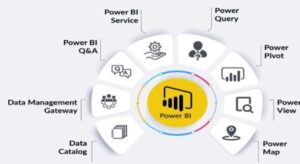Power BI is an interactive tool for business intelligence and data visualization. This is the platform that provides nontechnical business users with tools for aggregating, analyzing, visualizing and sharing data. Power BI is a fantastic tool for analyzing data and uncovering key insights. Nevertheless, we know grass is not greener on the other side so it’s time to throw some light on the downside of Power BI. A few manifestations resulting from this downside are greater operational support or maintenance, higher costs, reduced performance, inefficient resource utilization, longer delivery timelines, handling large data volumes, crowded user interface, etc.
This is a very broad topic and Microsoft has already provided solution to support many more known issues. Depending on the scale and goals of Power BI deployment, along with organizations policies, available resources, and other factors these indications may or may not be impactful to our development.
Here are few shortcomings listed:
Misconception of Power BI Artifacts:
Power BI artifact types include datasets, reports, dashboards and dataflows. There is lack of clarity among users and other stakeholders about the fundamentals of Power BI artifacts and how they relate to one another. In Power BI, many of the collaborators and business professionals relate everything to the term ‘dashboard’, however Power BI dashboard are rarely used amongst known crowd. With this understanding one could end up using only one feature of the Power BI without taking advantage of other artifacts like dataflows, reports, etc.
Struggle with large data volumes:
Power BI has limit on ingesting data up to 2GB. When you reach the limit, there is a need to recondition from free versions to paid versions. Also, Power BI takes more time than usual while loading millions of rows and columns of data.
Rigorous Formulae:
The language used throughout Microsoft Power BI for creating calculated columns, measures and custom table is DAX (Data Analysis Expression). DAX can be challenging to those who are new to formulas in Excel. In addition to DAX, some extent of SQL and/or Power query (M) has always been required. Sometimes even custom expressions are also needed in support of SSRS or paginated reports, custom PowerShell scripts to support data models and Analysis Services, and even some R, Python, MDX (Multidimensional Data Expressions) and so on.
Role of Datasets:
Power BI dataset represent a source of data ready for reporting and visualization. As a Power BI developer, one of the criteria we look up on when starting a new project is the count of report per dataset. Eventually whenever a report is created corresponding dataset is created. Before you start building a new Power BI project, particularly one that imports data from sources, IT personnel should at least confirm that a dataset/data model doesn’t already exist with the required data if a new dataset is required, try to think more broadly about how your dataset will support multiple reports.
Power BI as ‘Visualization’ tool only:
Sometimes Power BI is thought of as something just needed to create the visualization. But in a broader sense Power BI contains the huge set of capabilities within the platform including dataflows, enterprise modelling, AI, paginated reports, etc. Power BI service itself has been integrated with many interactive features.
Power BI has diverse capabilities of the platform, if users and IT folks are unaware of these platforms, they may simply presume Power BI can’t solve an issue. For example, certain business professionals may be availing Alteryx for self-service data transformation processes and have no idea about Power Query (M) or dataflows and the benefits of integrating their data transformation processes within Power BI.

Restriction in modification of visuals:
Despite of the fact that visualization on Power BI is very attractive and interactive, there are limited number of options in which one can alter or configure to meet the customer requirements. There are no code custom visuals available to provide optimized solution.
Complex in Nature:
This is one of the remarkable limitations as Microsoft has planned Power BI in a tremendously complicate way. Power BI has an extensive analysis of parts, and it is hard to recognize which part one might require. To give an instance, there’s a Power BI Desktop, Power BI Gateway, Power BI Service, Power BI Mobile Apps, Power BI Embedded, Power BI Report Server, Power BI Visuals Marketplace and so on. In addition, there are no moving parts accessible for this tool, which may cause one to invest a great deal of time and energy required to sort out the capacity of each part. This makes the product more complex and difficult to understand.
Table Relationships are sensitive:
Power BI is extremely rigid to encounter relationships between table. If there are more than one link between the tables, Power BI might not handle such relationship well. Then there is a need to create data model which contains more unique fields so that Power BI does not confuse the relationships in complex scenarios.
Wrapping up
This concludes our discussion on the downside of Power BI. But the reality lies in the fact that Power BI has already became such a greater part for so many businesses across the world. Offered at an affordable price with a versatile portfolio of features, coupled with its cloud capabilities, Power BI has gained a remarkable position in global market irrespective of the shortcomings listed above. Moreover, Microsoft is constantly upgrading new features and also working on to make improvements, resolving the know issues so we can expect better and more accurate versions to come.

